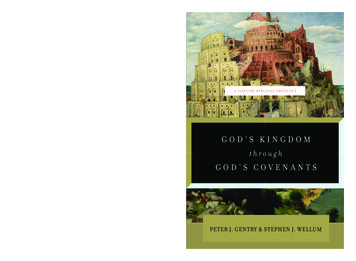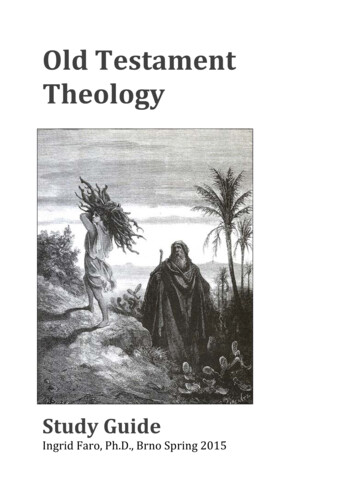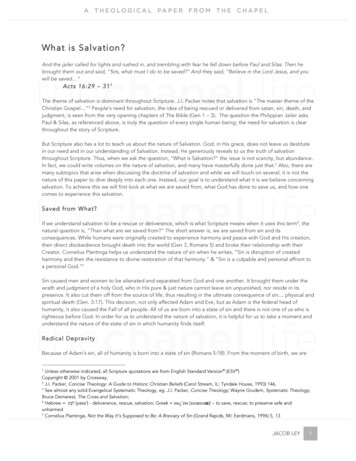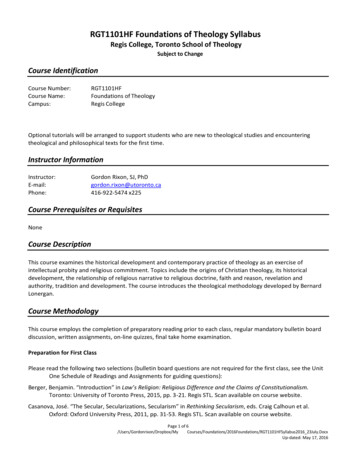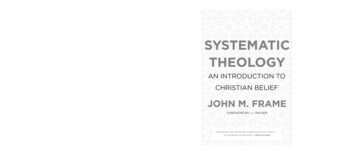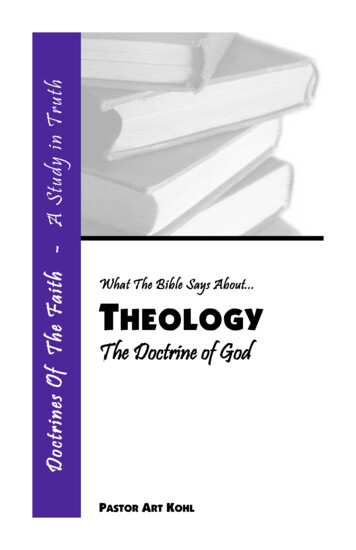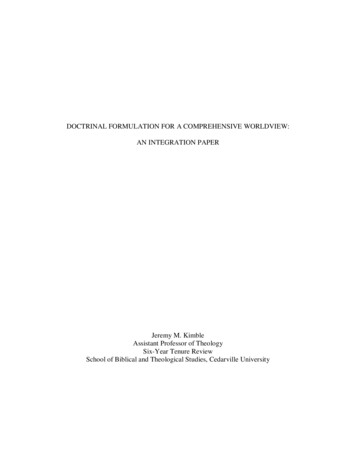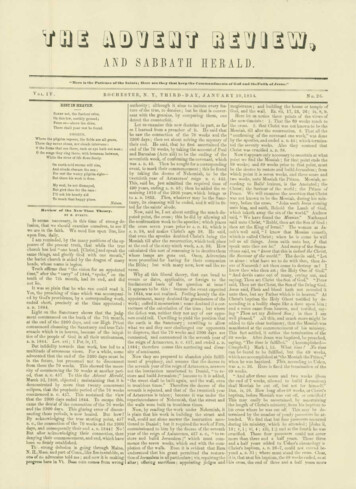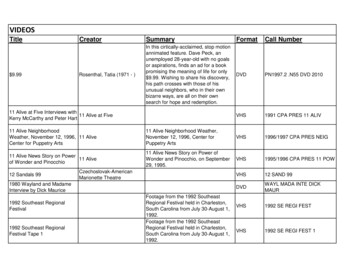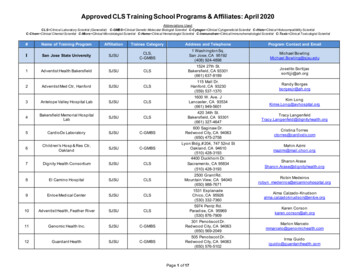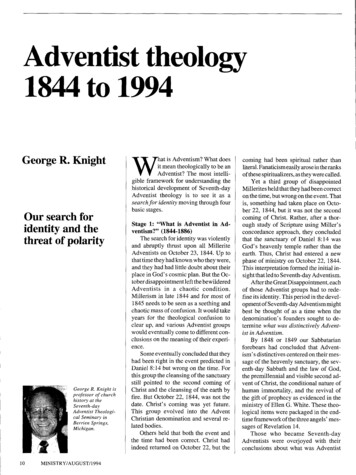
Transcription
Adventist theology1844 to 1994George R. KnightOur search foridentity and thethreat of polarityGeorge R. Knight isprofessor of churchhistory at theSeventh-dayAdventist Theological Seminary inBerrien Springs,Michigan.10MINISTRY/AUGUST/1994"W "V That is Adventism? What does\/\/ it mean theologically to be anT T Adventist? The most intelligible framework for understanding thehistorical development of Seventh-dayAdventist theology is to see it as asearch for identity moving through fourbasic stages.Stage 1: "What is Adventist in Adventism?" (1844-1886)The search for identity was violentlyand abruptly thrust upon all MilleriteAdventists on October 23, 1844. Up tothat time they had known who they were,and they had had little doubt about theirplace in God's cosmic plan. But the October disappointment left the bewilderedAdventists in a chaotic condition.Millerism in late 1844 and for most of1845 needs to be seen as a seething andchaotic mass of confusion. It would takeyears for the theological confusion toclear up, and various Adventist groupswould eventually come to different conclusions on the meaning of their experience.Some eventually concluded that theyhad been right in the event predicted inDaniel 8:14 but wrong on the time. Forthis group the cleansing of the sanctuarystill pointed to the second coming ofChrist and the cleansing of the earth byfire. But October 22, 1844, was not thedate. Christ's coming was yet future.This group evolved into the AdventChristian denomination and several related bodies.Others held that both the event andthe time had been correct. Christ hadindeed returned on October 22, but thecoming had been spiritual rather thanliteral. Fanaticism easily arose in the ranksof these spiritualizers, as they were called.Yet a third group of disappointedMillerites held that they had been correcton the time, but wrong on the event. Thatis, something had taken place on October 22, 1844, but it was not the secondcoming of Christ. Rather, after a thorough study of Scripture using Miller'sconcordance approach, they concludedthat the sanctuary of Daniel 8:14 wasGod's heavenly temple rather than theearth. Thus, Christ had entered a newphase of ministry on October 22, 1844.This interpretation formed the initial insight that led to Seventh-day Adventism.After the Great Disappointment, eachof those Adventist groups had to redefine its identity. This period in the development of Seventh-day Adventism mightbest be thought of as a time when thedenomination's founders sought to determine what was distinctively Adventist in Adventism.By 1848 or 1849 our Sabbatarianforebears had concluded that Adventism's distinctives centered on their message of the heavenly sanctuary, the seventh-day Sabbath and the law of God,the premillennial and visible second advent of Christ, the conditional nature ofhuman immortality, and the revival ofthe gift of prophecy as evidenced in theministry of Ellen G. White. These theological items were packaged in the endtime framework of the three angels' messages of Revelation 14.Those who became Seventh-dayAdventists were overjoyed with theirconclusions about what was Adventist
in Adventism. For the next 40 years theyboldly preached their distinctive theology to the world around them. Feelinglittle need to emphasize such items asfaith, grace, or other beliefs shared withthe larger Christian world of the day,they emphasized their distinctive beliefs especially the law of God and theseventh-day Sabbath.Unfortunately, 40 years of emphasizing what is Adventist in Adventismled them into a disjunction with basicChristianity. That problem would comeinto bold relief between 1886 and 1888.Stage 2: "What is Christian in Adventism?" (1886-1920)The magnitude of the theologicalgroundshift taking place amongAdventists in the late 1880s and the 1890sis no secret to anyone with the slightestinterest in the development of Adventisttheology. Suddenly the denominationwas faced with a new theological emphasis, a new vocabulary, and a newquestion as to religious identity.It had all started simply enough. Tworelatively young editors from California A. T. Jones and E. J. Waggonerhad challenged the traditional Adventistinterpretation of the 10 horns of Daniel 7and the nature of the law in the book ofGalatians. But G. I. Butler and UriahSmith, the official leaders of the denomination, interpreted their challenge as anattack on the integrity of historic Adventism. As a result, they became aggressive with Jones and Waggoner anddid everything in their power to keep theyounger men from getting a hearing inthe denomination.The confrontation between the twosides came to a head at the Minneapolissession of the General Conference in theautumn of 1888. Thatmeeting witnesseda meanness of spirit on the part of thosedefending historic Adventism that ledEllen White to declare that they wereseeking to win the battle by using thespirit of the Pharisees. Shedeplored suchtactics. To her the 1888 session was the"most incomprehensible tug-of-war wehave ever had among our people." Again,she looked back at the session as "one ofthe saddest chapters in the history of thebelievers in present truth."Both the spirit and the theology of thedenomination's leading ministers, shesoon concluded, lacked a crucial element Christ and Christlikeness. As aresult, she recalled: "My burden duringthe meeting was to present Jesus and Hislove before my brethren, for I saw markedevidences that many had not the spirit ofChrist." And on October 24 she told thedelegates: "We want the truth as it is inJesus. I have seen that precious soulswho would have embraced the truth havebeen turned away from it because of themanner in which the truth has beenhandled, because Jesus was not in it. Andthis is what I have been pleading withyou for all the time we want Jesus.All the object I had was that the lightshould be gathered up, and the Saviourcome in."Coupled with Jones and Waggoner,Ellen White uplifted basic Christianthemes at Minneapolis and in subsequentyears. They especially uplifted Jesus andrighteousness by faith in Him.That new emphasis was reflected inEllen White's writings by a new direction in her literary effort. The first booklength contribution to her new emphasiscame in 1892 as Steps to Christ a volume she refused to put out to denominational publishing houses because she didnot trust those in charge to present hergospel message to the people in itsunadulterated form. Rather, Steps toChrist was published by Fleming H.Revell, Moody's brother-in-law. Ofcourse, she also hoped to reach a broaderaudience by publishing with Revell.Steps to Christ would be followed byThoughts From the Mount ofBlessing in1896 (also published by Revell), TheDesire of Ages in 1898, Christ's ObjectLessons in 1900, and the opening chapters of The Ministry of Healing in 1905.The new emphasis was also reflectedin the vocabularies of Waggoner, Jones,and W. W. Prescott as they preachedChrist and His saving grace to thedenomination's clergy and members.Whereas these younger men emphasizedwords like "Christ," "faith," "justification by faith," and terms related to Christ'srighteousness, the denomination's oldertheologians put the emphasis on suchwords as "works," "obedience," "law,""commandments," "our righteousness,"and "justification by works."The 1888 meetings set the stage for amajor theological shift in Adventism.Between 1888 and 1900 the denomination would arrive at a better understanding of salvation in Christ, the Trinity, thepersonhood of the Holy Spirit, and afuller understanding of the divine natureof Christ that would begin to displaceAdventism's semi-Arianism. In addition,certain of its theologians initiated interpretations regarding the human nature ofChrist being exactly like the nature of thefallen Adam that would set the stage forconflict in the 1990s, and the churchwould be treated to forceful attempts byEllen White to make the Bible ratherthan her own writings the determinantof Adventist theology.The new theological emphasis raisedat Minneapolis had caused an earthquakein Adventism. In essence the earthquakehad been brought about by a new question. The tectonic plate of the old question "What is Adventist in Adventism?"had run smack-dab into the tectonic plateof the new question "What is Christianin Adventism?"Unfortunately, most of those whohad spent their lives preaching the answer to the first question saw the secondas a threat to the first rather than as anenrichment. Thus the 1890s saw war inthe Adventist theological camp at thevery time when necessary enrichmentwas what was being advocated. After all,Seventh-day Adventism at its best is bothChristian and Adventist in its identity.That insight, however, was not obviousto the denomination's theological gladiators in the late 1890s and has yet todawn upon many of their heirs in 1994.Perhaps the greatest tragedy of 1888and the post-Minneapolis period is thatthe denomination's theologians had become polarized and no longer served ashealthy checks and balances on eachother's viewpoints.The Adventist brethren on the different sides of the theological fence hadfailed to learn one of the great lessons ofthe 1888 General Conference sessionthat they needed each other if they wereto maintain theological balance. Thecondition of things among Adventisttheologians in 1892 led Ellen White towrite in that year that Satan "has a hellishjubilee" "when he can divide brethren."She and others in the 1890s would repeatedly point out that many of the serious problems in Adventism could haveMINISTRY/AUGUST/l 99411
been avoided had the two sides learnedto learn from each other. Having achievedthat, they could have pulled togethertoward Adventism's theological and experiential center.Unfortunately, between 1888 and1900 Adventism kind of rocked alongwithout bringing full unity to its theology. In other words, the marriage between what was Adventist in Adventismand what was Christian in Adventismwas never successfully consummated.Theological polarity was a better descriptor of the Adventist theologicalworld in the early 1890s than was that ofunity or mutual respect. The identitycrisis continued, even though it seems tohave been masked by a pragmatic harmony and excitement in the area ofthe unprecedented spread of"Adventist missions.But even that outward harmonywould be shattered soon after theturn of the century as the denomination faced multiple theologicalcrises in the forms of the holy fleshmovement, pantheism, and A. F.Ballenger's teachings on the sanctuary doctrine.The polarity among Adventism's theologians during the 1890sleft the denomination theologicallyoff center and ill-prepared to meetthe challenges of the new century.Thus the early years of the 1900switnessed Adventism in the turmoil of a major identity crisis andschism. Many issues in that crisiswould be moving toward resolution by 1920, only to be faced by newchallenges that would contribute theirown complicating heritage for Adventisttheology in 1994. Out of the new challenges of the 1920s would come a newcrisis in Adventist identity and a newquestion regarding the essential natureof Adventism.Stage 3: "What is fundamentalist inAdventism?" (1920-1956)The new question in Adventist identity in the 1920s would be "What isfundamentalist in Adventism?" The1920s form a watershed in Americanreligious history. For more than a halfcentury forces within Protestantism hadbeen building toward a major break between what were coming to be known as12MINISTRY/AUGUST/1994liberalism and fundamentalism. Thebattle would come to a head in the early1920s around at least eight issues, withthe fundamentalist holding for verbalinspiration and an inerrant Bible, thehistoricity of the virgin birth, the necessity of the substitutionary atonement ofChrist, the historicity of Christ's resurrection from the dead, His premillennialreturn, the authenticity of miracles, theuniqueness of the Christian revelation inthe plan of salvation, and divine creationby fiat as opposed to theistic evolution.The liberals, of course, held to the opposite position on those eight points. Inreality, the fundamentalists were reacting vigorously to the liberal formulations of those doctrines.The Adventist brethrenon the different sides ofthe theological fence hadfailed to learn one of thegreat lessons of the 1888General Conferencesession that theyneeded each other ifthey were to maintaintheological balance.Adventists had traditionally heldseven of the eight theological positionsset forth by the fundamentalists. But thedenomination had never officially espoused verbal inspiration or an inerrantBible, even though such theological leaders as S. N. Haskell, A. T. Jones, the earlyW. W. Prescott, and many others certainly did. The General Conference during its 1883 session had gone on recordas accepting thought rather than verbalinspiration. And inerrancy had neverbeen a formal issue. Yet in spite of themoderate official stand of Adventism oninspiration, a great deal of discussiontook place as if the denomination didhave a verbalist and inerrantist view.That viewpoint would be extended andbecome even more explicit and moreconsistently expressed during the 1920s.During that decade, Adventism wasliterally forced into the arms of fundamentalism in the face of the unprecedented polarization taking place in Protestantism. At this point it is crucial torecognize that there was no neutral theological ground in the 1920s. Either onewas a liberal or a fundamentalist, andAdventism certainly had much more incommon with the fundamentalists thanwith the liberals. In the frenzy of thetimes, Adventism was thrust toward fundamentalism in spite of its traditionallymore moderate view on inspiration amoderation definitely supported by therecently deceased Ellen White.The magnitude of the groundshift inAdventism over inspiration during""* the 1920s is evidenced by the factthat the leaders who spoke outopenly for a moderate view of inspiration at the 1919 Bible conference lost their positions in the1920s. In fact, the inspiration issuebecame a major lever at the 1922General Conference session to unseat the powerful A. G. Daniells,who had been the denomination'spresident since 1901.On the other hand, B. L. House,who argued against the more moderate view of inspiration atthe 1919meetings, would be selected to writethe denomination's college-levelBible doctrines textbook that appeared in 1926. House held notonly for "verbal inspiration," butthat "the selection of the very wordsof Scripture in the original languageswas overruled by the Holy Spirit," aswas the selection of historical data. Asimilar perspective was set forth by otherdenominational publications in the1920s.The more rigid view of the inspiration of both the Bible and the writings ofEllen White would shape Adventism fordecades and would not face significantchallenge within Adventism until the late1970s and 1980s. Now, in the 1990s, ithas become a major factor in Seventhday Adventist theological dialogue.Meanwhile, another contribution tothe 1990s dialogue would be developedby M. L. Andreasen in the 1930s as afull-blown "final generation theology"a theology that emphasized that the sec-
ond advent of Jesus was dependent upona behaviorally perfect Adventist Church.Final generation theology was still inseed form in the 1890s, but it wouldmove to center stage between the late1950s and 1990s.That brings us to the mid- 1950s and thelatest groundshift in Adventist theology.Stage 4: "Adventism in theological tension" (1956-1994)A new crisis and theological alignment erupted with the 1956 publicationof Donald Grey Barnhouse's Eternitymagazine article entitled "Are Seventhday Adventists Christians?" In that article, with the apparent approval of L. E.Froom and R. A. Anderson (foremostAdventist leaders), Barnhouse publiclyrelegated M. L. Andreasen (Adventism'sleading theologian in the 1930s and1940s) and his theology to the "lunaticfringe" of Adventism and inferred thatAndreasen and his type were similar tothe "wild-eyed irresponsibles" thatplague "every field of fundamental Christianity." Meanwhile, the denomination,under the influence of Froom, Anderson, and W. E. Read, published Questions on Doctrine, a book that fanned theflames of the developing controversy.Andreasen retaliated with his Lettersto the Churches, in which he charged thedenomination with rejecting both thewritings of Ellen White and historicAdventism. Andreasen's reward was theremoval of his ministerial credentialsand the withdrawal of his books fromdenominational bookstores.Then in 1960 Zondervan PublishingHouse released Walter Martin's TheTruth About Seventh-day Adventism. Inthe book's foreword Barnhouse indicated that a major split in Adventist rankshad arisen over Questions on Doctrineand evangelical recognition. He went onto write that "only. those Seventh-dayAdventists who follow the Lord in thesame way as their leaders who haveinterpreted for us the doctrinal positionof their church are to be considered truemembers of the body of Christ."At that point the stage had beensetbyboth Adventist insiders and outsiders fora split in Adventism's theological ranks.I would suggest that since the mid1950s Adventism can best be defined asbeing in theological tension. All the oldquestions are still being asked in 1994,but now they are being asked at the sametime by differing factions and individuals. Some, for example, are inquiring:"What is distinctively Adventist in Adventism?" They tend to focus on Andreasen's perfectionistic theology coupledwith insights offered by Robert Wielandand Donald Short, who in the early 1950sshocked the denominational leaders bysuggesting that their forerunners had ledAdventism astray by rejecting the message of Jones and Waggoner at Minneapolis in 1888 and subsequent years.As of 1994 the "Adventist Adventist"faction of Adventism emphasizes thesinful post-Fall nature of Christ, the necessity of what amounts to some sort ofsinless behavioral perfectionism, finalgeneration theology, and what it increasingly refers to as "historic Adventism."In theological method it practices a veryheavy reliance upon the writings of EllenWhite and often sees Jones andWaggoner as having the final word onrighteousness by faith. The AdventistAdventists tend to be weak in their use ofthe Bible.Present-day Adventism also has amajor theological faction asking: "Whatis Christian in Adventism?" At its bestthis group uplifts the centrality of Christand the cross in salvation, views thebasis of assurance as being "in Christ,"with the saved Christian being both justified and in the process of being sanctified; and seeks to place the Bible at thecenter of its theological methodology.While it firmly upholds the distinctivelyAdventist doctrines, this faction emphasizes those doctrines within the contextof basic Christianity.Also alive and well in Adventism's1994 theological world are those whoare asking: "What is fundamentalist inAdventism?" This faction may holdviews in common with either those emphasizing that which is Adventist inAdventism or those stressing that whichis Christian in Adventism, but their special burden is the fundamentalist concerns of the 1920s.Those divisions in the present-dayAdventist theological world would beserious enough, but they have been aggravated by the multiple shocks to thecertitude of Adventist identity resultingfrom the Numbers, Rea, Ford, and Davenport crises of the late 1970s and early1980s, plus the fact that the agingAdventist movement has arrived at its150th birthday, and by the same unfortunate polarizing effects that did so muchto weaken the denomination in the 1890s.One cause ofthe polarity problem is thatin a desire to escape from one sort ofperceived error, people are liable to backinto the polar opposite.In Adventism in 1994, theologicalactivity is shaping up along two fronts,with all the old questions providing thedividing lines. Thus, in the confrontationbetween those emphasizing that which isAdventist in Adventism and those emphasizing that which is Christian in Adventism there is the ever-present dangerthat the opposing forces will becomeever more one-sided in their interpretations.The crisis issue for the AdventistAdventists is that they will lose contactwith basic Christianity as they focus onnonbiblical sources for theological authority and force a true biblical conceptof perfection into a sort of itemized sinlessperfectionism. At the other extreme isthe ever-present danger that in seekingto avoid the Adventist Adventist errorsome will be tempted to deny their Adventism through one-sided emphases andthus become "Christian Christians." /suggest that there is adequate defensiblemiddle ground for those who might bedesignated as "Christian Adventists " ifand only if they keep their eyes on theBible and avoid the distorting dynamicbuilt into the very process ofdoing theology, when doing theology becomes primarily an exercise in doing theologyagainst one's opponent. The distortingfactor comes into action when individuals consciously or unconsciously place aprimary emphasis on putting mere distance between themselves and what theyconsider to be error and when they conclude that they can learn nothing of valuefrom those who differ from them.The Adventist Adventist versusChristian Adventist polarizing effectwaspresent in the 1890s, but in 1994 Adventism is also being challenged by asecond polarizing dynamic. While someindividuals fear liberalism and appear tobe reaching for the fundamentalism ofthe 1920s (apparently confusing it with(Continued on page 25)MINISTRY/AUGUST/l 99413
the apostles.Adventist Theology1844 to 1994From page 13the mind-set of pristine Christianity inthe process), other Adventist thoughtleaders (in their desire to escape whatthey consider to be the theological errorsand extremes of fundamentalism) are indanger of backing into an advocacy ofthe liberal Christianity of the 1920s. Atthe basis of this polarization arehermeneutical/epistemological issues ofthe first rank especially that of the primacy between revelation and reason. Butit should be recognized by all parties,that a modernist view (as was espousedby the liberals in the 1920s) that hasadopted the enlightenment emphasis onthe supremacy of human reason aboveScripture is no more healthy than thefundamentalist error that confuses 1920srigidities with the mind-set of Christ andValuable lessonsIn closing, I would suggest that Seventh-day Adventist theologians in theirsearch for identity face the same basicdynamic in 1994 that they faced in the1890s the dynamic of polarization. Ofcourse, in 1994 the dynamic is morecomplex since the conflict is being foughtby more actors and, more important, ontwo distinct but overlapping fronts at thesame time. But the dangers are the same.Any religious group is in trouble ifand when its theology is being formulated primarily in opposition to a real orperceived polar position. That very dynamic sets the stagefor more rapid stridestoward both further polarization andadditional theological distortion. Onemust be aware of those dynamics as he orshe seeks to do biblical theology in thespirit of Christian Adventism at its best.We learn not only from the dangersfaced by Adventist theologians in the1890s, but also from the possible solutions that lay at their fingertips. The mainlesson for us is one that our forebearsfailed to grasp that the advocates ofAdventism's polar positions need eachother. It is difficult and probably impossible for any individual or group to betotally wrong or totally correct. All of ushave captured important aspects of truthas well as portions of error. And all of uscan learn from those holding theologicalpositions contrary to our own. But inorder so to learn, it is mandatory that weinternalize the spirit of Christ a spiritthat not only thinks the best of others, butone that maintains an openness to truthfrom all sources.One key to theological health is tokeep our eyes focused on the seemingintent of Scripture and the essentials ofboth Christianity and Adventism. A second key to theological health is to learnfrom each other and to back away fromideologically defensive positions asAdventist theology seeks to continueguiding the church in its extended andongoing search for identity.The Tide ofBUILD HAOrder from Publishing Department, General Conference,12501 Old Columbia Pike, Silver Spring, Md. 20904Tel: 301-680-6480THE TEXBOOKof family principles byFloyd and Ellen Bresee,contributing authorVirgina Smith106 pages 1.50 plus S&HONES WITHTRAINING PACKAGE* 37 Overheads* Teacher's guide» Handouts* Handy binder 65.00 plus S&HMINISTRY/AUGUST/199425
Ellen White uplifted basic Christian themes at Minneapolis and in subsequent years. They especially uplifted Jesus and righteousness by faith in Him. That new emphasis was reflected in Ellen White's writings by a new direc tion in her literary effort. The first book- length contribution
